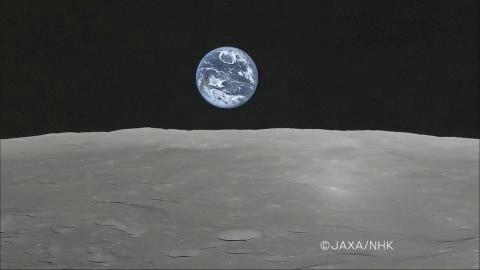Beauty Shot: Moon Probe Catches Full Earthrise

A Japanesespacecraft orbiting the moon has beamed back stunning footage of a round, blueEarth rising above the lunar horizon.
The high-definitionvideo camera aboard Japan?s lunar orbiter Kaguya caught the rare view of thefull Earth as it rose above the moon?s horizon on April 5, the Japan AerospaceExploration Agency (JAXA) officials said in a recent statement after releasing a shortvideo of the event.
?This isthe first time that a high-[definition] image of the ?Full Earth-rise? has beencaptured from space,? JAXA officials said.
The sun,Earth, moon and Kaguya have to line up just right in order to present a full,orb-like Earth to the spacecraft?s camera, an arrangement that only occursabout twice a year, they added.
The three-tonKaguya spacecraft recorded the rising Earth view from lunar orbit at a distanceof about 236,121 miles (380,000 km) from its home planet.
The probe?shigh-definition television camera, which was provided by the Japan BroadcastingCorporation (NHK), has recorded an Earthrise before during aNov. 7, 2007 orbit. But that pass caught a waning Earth, not the full,bright disc spotted on April 5, JAXA officials said.
Named aftera moon princess in a Japanese folktale, Japan?s Kaguya spacecraft launchedtoward the moon in September 2007 on a one-year mission to explore thelunar surface. JAXA officials have since said that the flight of Kaguya, alsoknown as the SELenological and ENgineering Explorer (SELENE), may be extended.
Get the Space.com Newsletter
Breaking space news, the latest updates on rocket launches, skywatching events and more!
The 55billion-yen ($480 million) orbiter carries 14 science instruments, includingthe high-definition camera, to study the lunar surface from an altitude ofabout 62 miles (100 km). The probe has also successfully deployed two miniaturesatellites to map the moon?s gravitational field.
- NEW VIDEO: A Full Earthrise at the Moon
- The Top 10 Views of Earth from Space
- Vote: The Best Moon Image
Join our Space Forums to keep talking space on the latest missions, night sky and more! And if you have a news tip, correction or comment, let us know at: community@space.com.

Tariq is the Editor-in-Chief of Space.com and joined the team in 2001, first as an intern and staff writer, and later as an editor. He covers human spaceflight, exploration and space science, as well as skywatching and entertainment. He became Space.com's Managing Editor in 2009 and Editor-in-Chief in 2019. Before joining Space.com, Tariq was a staff reporter for The Los Angeles Times covering education and city beats in La Habra, Fullerton and Huntington Beach. In October 2022, Tariq received the Harry Kolcum Award for excellence in space reporting from the National Space Club Florida Committee. He is also an Eagle Scout (yes, he has the Space Exploration merit badge) and went to Space Camp four times as a kid and a fifth time as an adult. He has journalism degrees from the University of Southern California and New York University. You can find Tariq at Space.com and as the co-host to the This Week In Space podcast with space historian Rod Pyle on the TWiT network. To see his latest project, you can follow Tariq on Twitter @tariqjmalik.









